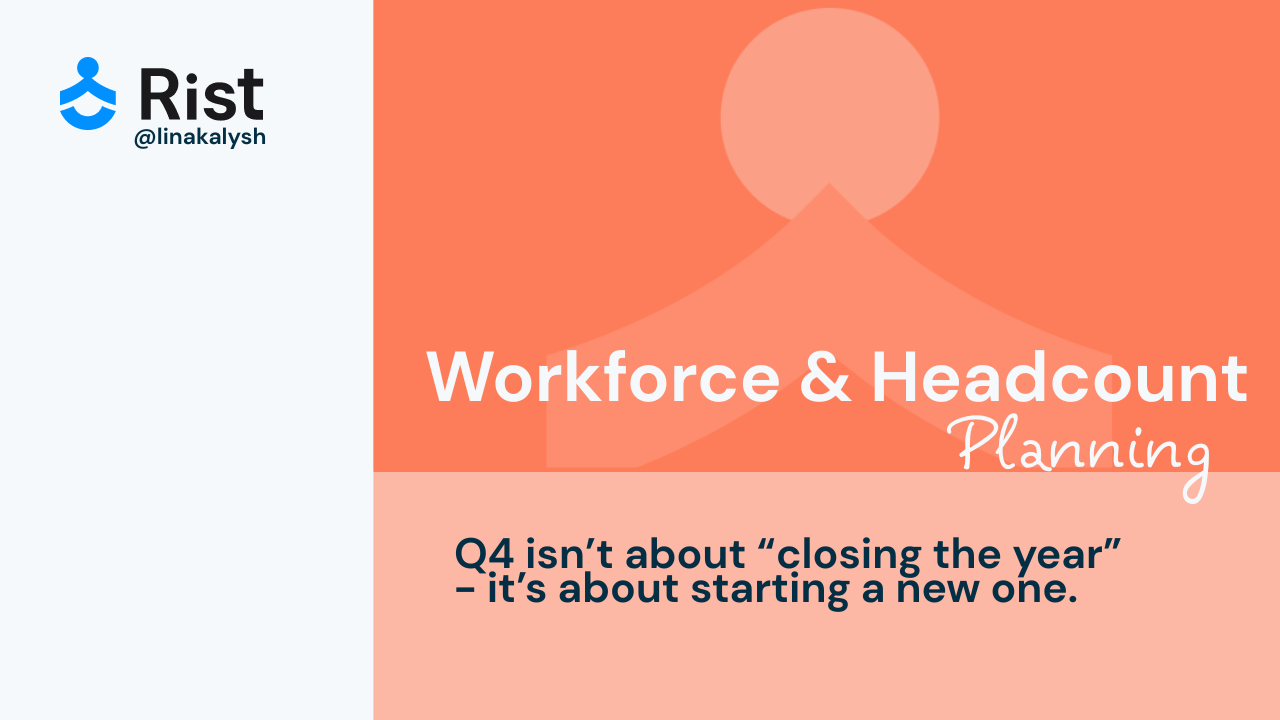Workforce & Headcount Planning: how to prepare for the new business year
Q4 isn’t about “closing the year” - it’s about starting a new one. Today, let’s talk about how Talent teams can prepare for the planning process.
Between October and December, everything is shaped - team structures, budgets, workloads, and Talent & HR expectations.
This is the moment when most companies either set themselves up for a strong start - or create chaos for the year ahead.
Workforce ≠ Headcount
Most companies start with the question:
“How many people do we need?”
But the right question is:
“What skills and roles do we need to achieve our business goals?”
Headcount planning is arithmetic:
number of FTEs, roles, salaries, and budgets
who’s on the team, who’s in reserve, and who needs to be hired
Workforce planning is strategy:
which business functions will grow and which will be automated
which skills are disappearing and which should be developed or bought from the market
how business strategy changes affect the org structure
🔍 In simple terms:
Headcount answers “how many?”
Workforce answers “who and why?”
🧠 Example:
A company decides to launch a new SaaS product in 2025.
The headcount plan says: “+2 developers.”
The workforce plan says: “We need a DevOps, an AI Engineer, and a Customer Success Manager - because the business model is changing.”
Who Should Be Involved in Planning
It’s not just a job for recruiters or finance.
Successful planning is a collaboration across three levels:
C-level / Strategic → Defines priorities, growth pace, and investment levels
HR / Talent / Finance → Translates business goals into numbers: FTEs, budgets, salary funds
Team Leads / Department Heads → Provide insights on workload, critical roles, and potential risks
💡 Tip: Build a cross-functional planning team with Talent, HR, Finance, and business leaders - it reduces chaos and conflicts during budgeting.
🧩 Real case:
At one startup, HR built the headcount plan alone.
Result: 8 new hires were approved, but by Q1 the product strategy shifted - half of the roles were no longer relevant.
If the CTO had been involved, they would’ve flagged that the team was changing its tech stack in Q2 and needed different specialists.
How to Prepare for Planning
Before kicking off meetings and budgets - do your homework:
1. Analyze the current year
How many roles were opened/closed
Time to Fill: 42 days on average (target: reduce to 35)
Cost per Hire: $850 (set a $1K limit for 2026)
Attrition rate: 18% (high turnover in Support)
Quality of Hire: 3.8/5 after 6 months in performance review
(Add your own key data - this is the base for forecasting)
2. Assess workload
In Sales: one manager handles 60 clients (burnout risk)
In Product: 3 roles remain constantly open
In Talent: one recruiter manages 25 active vacancies
📊 Tip: Calculate Recruiter Capacity - how many vacancies one recruiter can realistically manage depending on role type (mass-hiring ≠ tech roles).
3. Forecast business goals & projects
New markets? → need local experts
Product strategy changing? → new technical skills required
Automation or outsourcing? → fewer FTEs, more contractors
🎯 Goal: Identify where growth is needed - and where automation or redistribution will bring efficiency.
How to Run the Planning Process
1. Kick-off meeting:
CEO, HR, Talent, COO, CFO, and team leads align on business goals for the year - not hiring numbers, but key directions for growth.
2. Data phase:
Talent & HR gather real data - current headcount, open vacancies, planned exits, rotations.
Finance prepares the budget and FTE cost forecast.
Managers provide team growth expectations.
3. Scenario planning:
Create three scenarios:
🟢 Optimistic: 20% growth, team expansion
⚪ Base: steady state, only key replacements
🔴 Conservative: hiring freeze or reductions
→ This helps avoid the “we had to cut headcount in March” situation.
4. Alignment session:
Gather all managers to align departmental needs - avoid hiring duplicate roles.
5. Budgeting:
Define key factors:
Cost of Growth (new roles)
Replacement Rate (expected natural attrition)
Upskilling Cost (train vs hire analysis)
6. Monitoring:
Compare actual vs planned headcount every quarter.
Common Mistakes in Planning
❌ Confusing busyness with effectiveness
→ If people are overloaded, that doesn’t always mean you need to hire. Sometimes the process is broken.
❌ Ignoring Learning & Development
→ Upskilling can replace 20–30% of hires if done right.
❌ Overlooking part-time and contractor options
→ 1 FTE ≠ 1 person. Sometimes 0.5 FTE + automation is more effective.
❌ Planning from the budget instead of goals
→ “We have budget for 5 people” is not a strategy.
The real question is: “What do we need to achieve the business outcome?”
Practical Tips That Work
✅ Keep a centralized, integrated headcount sheet
HRIS (e.g., BambooHR, PeopleForce, Recruitee) + Finance = live, accurate data.
✅ Use heatmaps to visualize workload
See which teams are overcapacity or underutilized.
✅ Build a skills matrix
Spot gaps and decide whether to hire or upskill.
✅ Do an annual post-mortem
Which roles didn’t work out? Where did hiring lag? Why?
✅ Involve business in the conversation
Talent shouldn’t just ask “who do we hire?” but say:
“To achieve your Q2 goals, we need to redesign roles and update skill sets in your team.”
Final Thoughts
Workforce planning is a strategic conversation about the company’s future, not just a spreadsheet of numbers.
Those who plan in October - win in January.
💬 How does your company approach headcount planning?
Is it a joint process - or something handed down from the top?
Share your experience in the comments 👇



